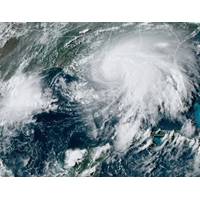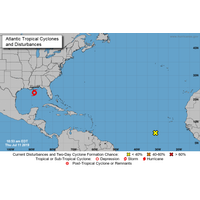US Natural Gas Hits High Amidst Cooler Outlook

U.S. natural gas futures hit a two-week high on Tuesday, underpinned by sharply colder 1–2 week forecasts that are lifting heating demand expectations, a month-to-date dip in output and strong LNG feedgas demand.Front-month gas futures for November delivery on the New York Mercantile Exchange rose 4.7 cents, or 1.4%, to $3.44 per million British thermal units (mmBtu) as of 10:09 a.m. ET, its highest level since October 8.Prices rose as much as 13% in the previous session."Further revisions to the 11-15 day outlooks…
US Natural Gas Prices Rise as LNG Exports Increase

U.S. natural gas futures climbed about 2% on Monday on near-record flows to liquefied natural gas (LNG) export plants and forecasts for more demand this week than previously expected.Front-month gas futures for November delivery on the New York Mercantile Exchange (NYMEX) rose 6.7 cents, or 2.0%, to $3.391 per million British thermal units (mmBtu) at 8:42 a.m. EDT (1242 GMT).In the cash market, average prices at the Waha Hub in West Texas, which fell to a record low of minus $7.07 per mmBtu on Thursday…
US Natural Gas Prices Drop 4% on Record Output

U.S. natural gas futures fell about 4% to a nine-month low on Tuesday on near-record output, ample fuel in stockpiles and forecasts for less hot weather and lower demand through early September than previously expected.Another factor weighing on gas prices was a decline in the amount of gas flowing to liquefied natural gas export plants due to small reductions at several facilities.Front-month gas futures for September delivery on the New York Mercantile Exchange fell 10.8 cents…
US Natural Gas Prices Drop 3% Ahead of Cooler Weather Forecasts

U.S. natural gas futures fell about 3% on Monday on near-record output, ample fuel in stockpiles and forecasts for less hot weather next week than previously expected.Front-month gas futures for September delivery on the New York Mercantile Exchange fell 9.5 cents, or 3.3%, to $2.821 per million British thermal units by 5:53 a.m. EDT (0953 GMT).The U.S. National Hurricane Center (NHC) projected Hurricane Erin, which was near the Bahamas, would move north and then east off the U.S.
US Natgas Prices Rise on Increasing Demand

U.S. natural gas futures edged up about 1% on Wednesday after dropping to an eight-month low in the prior session on forecasts for more demand over the next two weeks than previously expected and near-record gas flows to liquefied natural gas (LNG) export plants.That small price increase came despite near-record output, ample supplies of the fuel in storage, and the approach of a storm that could affect the U.S. East Coast as a demand-destroying hurricane next week.
US Natural Gas Prices Rise to Two-Week High Amidst Hot Weather

U.S. natural gas futures edged up about 1% to a two-week high on Wednesday as hot weather boosts the amount of gas power generators must burn to keep air conditioners humming and on near-record flows of gas to LNG export plants.Front-month gas futures for August delivery on the New York Mercantile Exchange rose 2.8 cents, or 0.8%, to settle at $3.551 per million British thermal units, their highest close since June 27 for a second day in a row.The U.S. National…
Oil Dips 2% as Hurricane Fears Ease
Oil prices fell more than 2% on Friday as traders grew less fearful of prolonged supply disruptions from a hurricane in the U.S. Gulf of Mexico, while China's latest economic-stimulus packages failed to impress some oil traders.U.S. West Texas Intermediate futures CLc1 led the decline, down 2.8%, or $2.01, at 70.35 per barrel by 1:32 p.m. ET (1832 GMT) . Global benchmark Brent crude futures LCOc1 fell 2.3%, or $1.77, to $73.86 per barrel.Energy producers shut in more than 22% of oil output in the U.S.
Prices of oil fall as Hurricane Rafael is expected to weaken
The oil prices dropped slightly on Friday, as the market continued to assess how Donald Trump's policy might impact supplies. Brent crude oil futures dropped 26 cents or 0.3% to $75.37 a barrel at 0209 GMT. U.S. West Texas Intermediate crude (WTI), gained 35 cents, or 0.5%, to $72.01. After a nearly 1% increase on Thursday, benchmarks dropped. Brent is expected to increase by 3.1% this week while WTI will rise 4.1%. The U.S. National Hurricane Center stated that Hurricane Rafael is forecast to move slowly to the west over the Gulf of Mexico, away from U.S.
Hurricane Rafael has caused a shutdown of 17% of the U.S. Gulf of Mexico Oil Production
The U.S. Bureau of Safety and Environmental Enforcement announced on Wednesday that Hurricane Rafael had shut down approximately 17% of crude production and 7% of gas output in the U.S. Gulf of Mexico. The Bureau reported that energy producers have shut down 304,418 barrels of oil per day and 131,000,000 cubic feet of gas production from Gulf waters. According to the latest U.S. National Hurricane Center advisory, Rafael, a hurricane of Category 3, was located approximately 70 miles (110 kilometers) south of Havana, Cuba.
Researchers say that a late-season storm could disrupt the US oil production by 4 million barrels.
Researchers said that a late-season tropical storm, which is predicted to intensify this week into a Category 2 hurricane in the U.S. Gulf of Mexico, could reduce U.S. crude oil production by approximately 4 million barrels. Storm Rafael, which was in the Caribbean Sea on Monday evening, is expected to move into the Gulf of Mexico via a path that will take it through oil-producing regions. The National Hurricane Center reported that winds could reach up to 100 miles per hour (161 km/h) on Tuesday. Earth Science Associates, an energy analytics firm, estimated that U.S.
Researchers say that a late-season storm could disrupt the US oil production by 4 million barrels.
Researchers said that a late-season tropical storm, which is predicted to intensify this week into a Category 2 hurricane in the U.S. Gulf of Mexico, could reduce U.S. crude oil production by approximately 4 million barrels. Storm Rafael, which was in the Caribbean Sea on Monday evening, is expected to move into the Gulf of Mexico via a path that will take it through oil-producing regions. The National Hurricane Center reported that winds could reach up to 100 miles per hour (161 km/h) on Tuesday. Earth Science Associates, an energy analytics firm, estimated that U.S.
Helene reaches hurricane strength in Gulf of Mexico and threatens Florida
The National Hurricane Center reported that the powerful storm Helene became a hurricane Wednesday morning. It was packing winds of up to 130 kph (80 mph) as it churned off the coast of Yucatan Peninsula in the eastern Gulf of Mexico. Forecasters said that Helene would continue to intensify throughout Thursday and bring a life-threatening storm to Florida's coast. The National Weather Service warned that more than 40 millions people in Florida and Georgia, as well as Alabama, were under tropical storm and hurricane warnings on Wednesday.
Cuba and Florida prepare for Tropical Storm Helene's impact
The U.S. National Weather Service reported that Tropical Storm Helene will cause mudslides, flooding and major hurricane-like conditions in Cuba. It is then expected to reach major hurricane status on Thursday when it reaches Florida with a life-threatening ocean tide. The National Hurricane Center in Miami said that Helene was moving northwest at a speed of 45 mph with sustained winds up to 72 kph. Forecasters say Helene is expected to strengthen rapidly over the warm waters of Gulf of Mexico, resulting in a major hurricane with winds up to 115 mph.
As a major hurricane approaches, oil companies are evacuating their staff from the Gulf of Mexico.
On Monday, U.S. producers of oil scrambled to evacuate their staff from offshore oil fields in the Gulf of Mexico as the second major storm to hit in two weeks is predicted to ravage them. The U.S. National Hurricane Center stated that a potential Tropical Cyclone over the warm waters of the Gulf could rapidly intensify and become a major Hurricane with winds up to 115 mph (185 kph). According to the NHC, the storm, called Helene, would hit the U.S. at a category 3 on the Saffir Simpson wind scale.
Hurricanes force oil companies to evacuate staff from the Gulf of Mexico
U.S. Oil Producers scrambled to evacuate their staff from Gulf of Mexico platforms on Monday as forecasters warned that the second major hurricane within two weeks would likely tear into offshore oil fields. The U.S. National Hurricane Center stated that a potential Tropical Cyclone System Nine, near the western tip of Cuba, was expected to intensify into a Hurricane on Wednesday as it moved across the eastern Gulf of Mexico. The NHC says that it could turn into a major hurricane by the time it reaches the Northeastern Gulf Coast.
Hurricane John will become a major storm before hitting Mexico's Pacific Coast
According to the National Hurricane Center in the United States, Storm John grew to Category 1 on Monday. It is expected to grow into a major hurricane before it hits Mexico's Pacific Coast. The NHC reported that Hurricane John had winds of up to 137 kph (85 mph) and higher gusts. A rapid strengthening was forecast. If winds reach 96 mph, the storm will become a Category 2. The NHC forecast indicated that John will make landfall near the resort destination Puerto Escondido on Tuesday.
Offshore Oil Wells, Ports Shut as Hurricane Sally Advances on U.S. Gulf

Energy companies, ports and refiners raced on Monday to shut down as Hurricane Sally grew stronger while lumbering toward the central U.S. Gulf Coast, the second significant hurricane to shutter oil and gas activity over the last month.The hurricane is disrupting oil imports and exports as the nation's sole offshore terminal, the Louisiana Offshore Oil Port (LOOP), stopped loading tanker ships on Sunday, while the port of New Orleans closed on Monday.The U.S. government said 21%…
Flooding Disrupts U.S. Gulf Coast Energy Operations
Energy infrastructure on the U.S. Gulf Coast was hit hard by Tropical Storm Imelda on Thursday, as flooding forced a major refinery, a key oil pipeline, terminals and a ship channel in Texas to shut, according to sources familiar with operations.Torrential rain has inundated the Gulf Coast from Houston to western Louisiana for a second straight day. The National Hurricane Center forecast the storm could drop up to 40 inches (102 cm) of rain along the southeastern coast of Texas through Thursday night.Ship pilots stopped boarding vessels on the Beaumont…
Tropical Storm Barry Forms in Gulf of Mexico

Tropical Storm Barry formed on Thursday with heavy rains expected across the north-central U.S. Gulf Coast, the National Hurricane Center said.Barry, the second named storm of the 2019 Atlantic hurricane season, was located about 95 miles (150 kilometers) south-southeast of the mouth of the Mississippi River at about 11 a.m. EDT with maximum sustained winds of 40 miles (65 km) per hour, the Miami-based weather forecaster said. (Reuters, Reporting by Swati Verma in Bengaluru Editing by Bill Trott)
Alberto Moves Inland, Flash Floods Threaten Alabama
Subtropical storm Alberto fizzled into a subtropical depression as it rolled into Alabama on Tuesday but forecasters warned of potentially dangerous flash floods even as winds dropped to 30 miles per hour (48 km per hour). At its height, Alberto, the first storm of the 2018 Atlantic hurricane season, blasted sustained winds of 65 mph (105 kph) with gusts that packed full hurricane punches of 75 mph (121 kph), said meteorologist David Roth of the National Weather Service. "It's slowly weakening and it's not regaining any strength," Roth said.